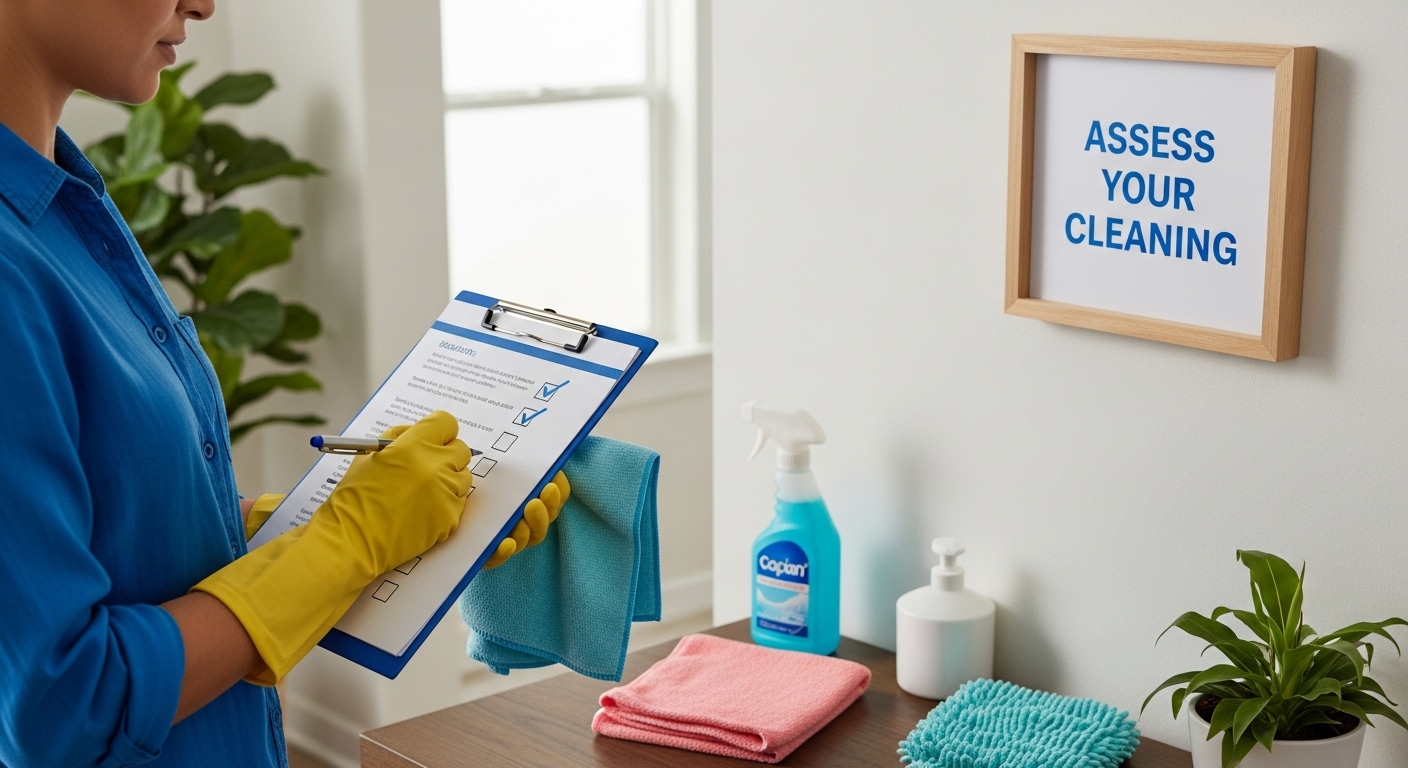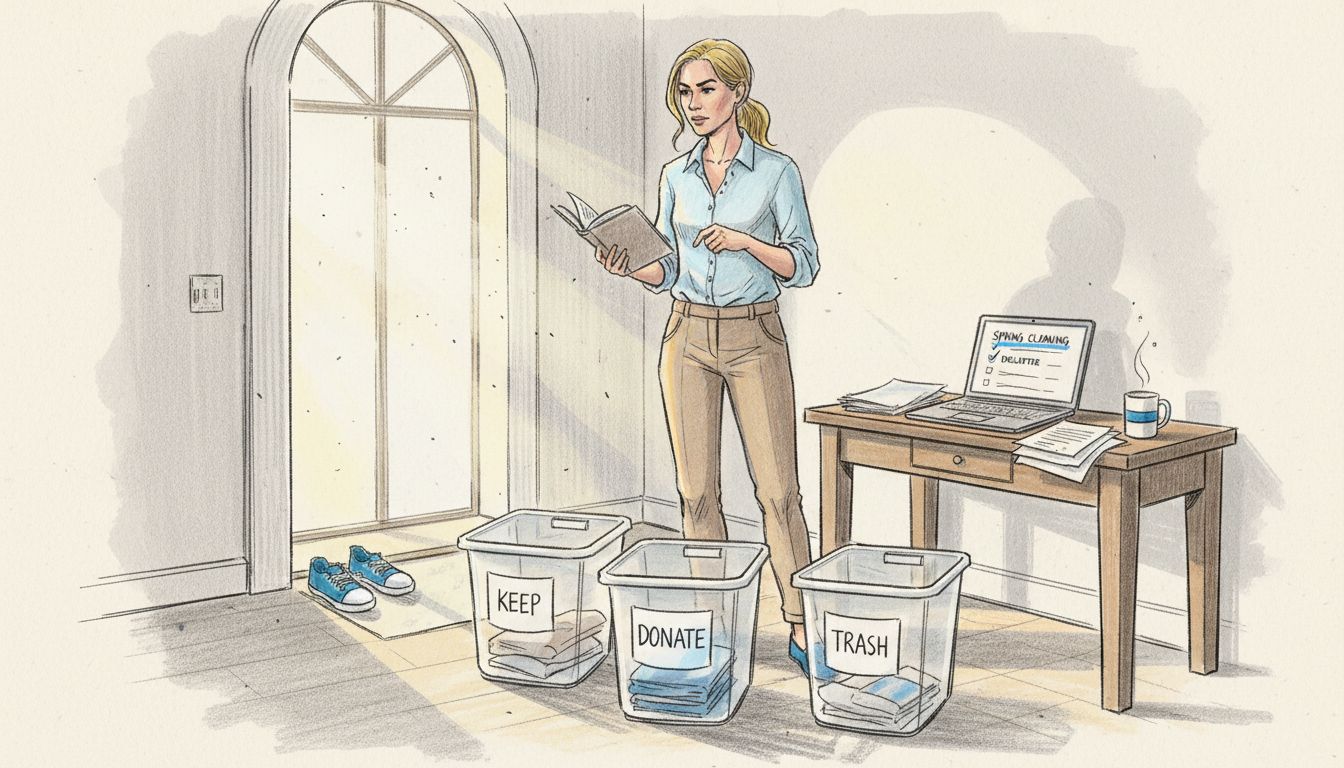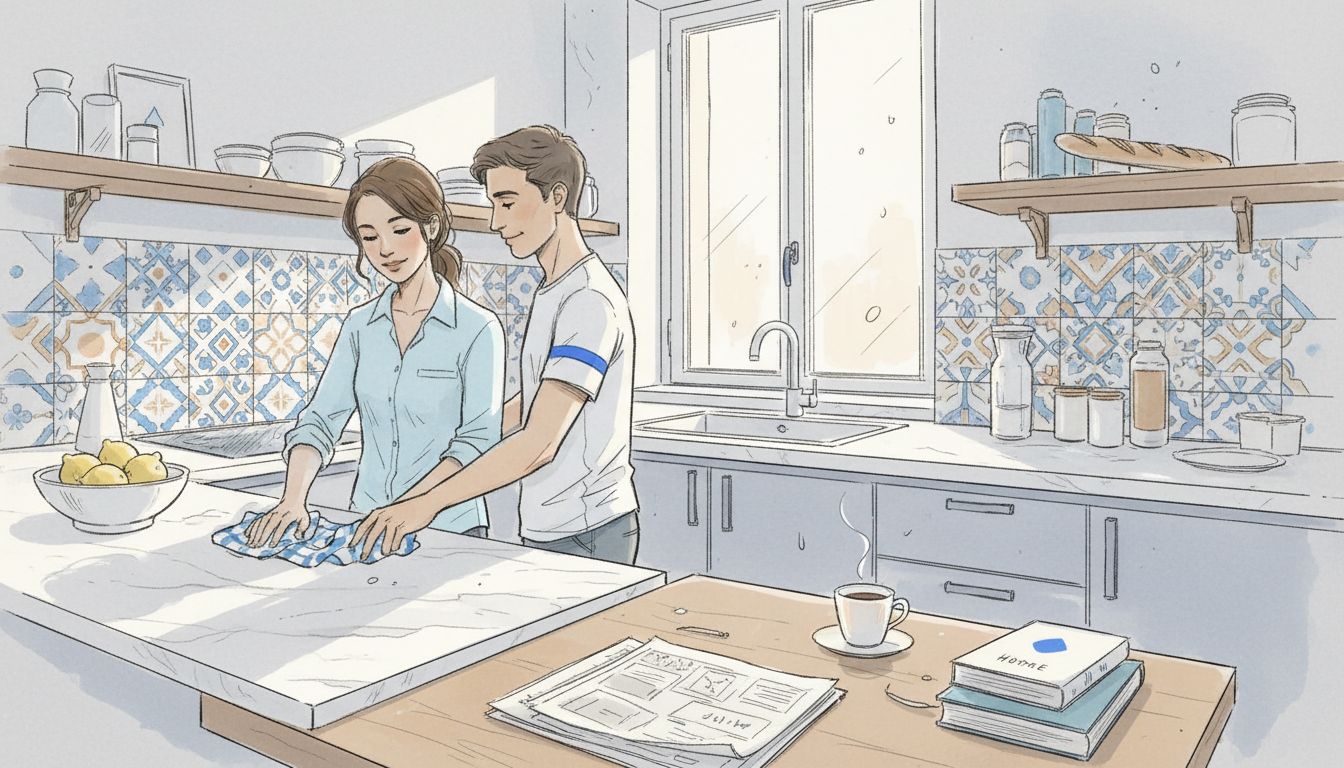Building a house cleaning schedule sounds like a chore in itself. Most people think you need hours of free time and a team of helpers just to keep things from falling apart. But the truth is, a well-planned routine can actually cut your cleaning time by as much as 30 percent and make your home feel spotless with just a few minutes each day. The trick is creating a plan that matches real life, not some Instagram fantasy.
Table of Contents
- Step 1: Assess Your Cleaning Needs And Priorities
- Step 2: Develop A Daily Cleaning Routine
- Step 3: Compile A Weekly Cleaning Checklist
- Step 4: Organize A Monthly Deep Clean Plan
- Step 5: Implement And Adjust Your Cleaning Schedule
- Step 6: Review And Optimize For Efficiency
Quick Summary
| Key Point | Explanation |
|---|---|
| 1. Assess cleaning needs uniquely | Tailor your cleaning plan based on your household’s specific dynamics and available time for effective maintenance. |
| 2. Establish a daily cleaning routine | Create quick daily tasks that become habits to maintain cleanliness without overwhelming yourself. |
| 3. Create a structured weekly checklist | Organize deeper cleaning tasks throughout the week to ensure comprehensive home maintenance without stress. |
| 4. Plan a thorough monthly deep clean | Focus on neglected areas each month to prevent long-term buildup and maintain a healthy living environment. |
| 5. Optimize and evaluate your routine | Regularly track cleaning efforts and adjust your schedule to maximize efficiency and reduce stress in maintaining cleanliness. |
Step 1: Assess Your Cleaning Needs and Priorities
Creating an effective house cleaning schedule starts with understanding your unique living environment and personal requirements. Your home is as individual as you are, which means a one-size-fits-all approach simply won’t work. The goal of this initial step is to develop a personalized cleaning strategy that matches your lifestyle, household composition, and available time.
Begin by conducting a comprehensive walkthrough of your living space. Observe each room critically and note areas that accumulate dirt, clutter, or require frequent attention. Consider your household dynamics – do you have children, pets, multiple occupants, or specific health considerations that might influence cleaning frequency? A home with young children or pets will naturally demand more frequent cleaning compared to a single-person apartment.
Next, evaluate your personal schedule and energy levels. Realistic planning is crucial. If you work long hours or have limited free time, your cleaning schedule must be efficient and manageable. According to American Cleaning Institute, successful home maintenance isn’t about perfection but consistent, strategic effort.
Take time to categorize cleaning tasks based on their urgency and impact. Some tasks require daily attention, while others can be addressed weekly or monthly. High-traffic areas like kitchens and bathrooms typically need more frequent cleaning, whereas guest rooms or storage spaces might require less frequent intervention.
Consider creating a visual map or simple spreadsheet to track your cleaning needs. This approach helps you identify patterns, potential problem areas, and develop a structured approach. Your mapping should include critical factors such as:
- Surface types in each room
- Frequency of use for different spaces
- Specific cleaning challenges unique to your home
Remember that an effective house cleaning schedule is flexible and adaptable. What works perfectly this month might need adjustment as your life circumstances change. Regular reassessment ensures your cleaning strategy remains practical and aligned with your evolving needs.
Step 2: Develop a Daily Cleaning Routine
A daily cleaning routine transforms chaos into consistent order, creating a foundation for a well-maintained home. These small, strategic actions prevent overwhelming messes and keep your living space consistently presentable and hygienic. Think of your daily routine as a series of quick, intentional tasks that take minimal time but deliver maximum impact.
Begin by establishing a morning ritual that sets a positive tone for household maintenance. Make your bed immediately after waking – this simple action creates an instant sense of accomplishment and visual tidiness. While preparing breakfast, wipe down kitchen counters and immediately clean dishes or load the dishwasher. These morning habits prevent dirty dishes from accumulating and create a clean starting point for the day.
According to East Carolina University, developing consistent daily practices is crucial for maintaining a clean living environment. Focus on high-traffic areas that quickly accumulate dirt and clutter. Spend 10-15 minutes each evening performing a quick pick-up routine. This involves returning items to their designated spaces, clearing surfaces, and doing a rapid sweep of main living areas.
Create a systematic approach to daily cleaning by establishing zones and specific time windows for tasks. Kitchen and dining areas should be addressed immediately after meals, while living spaces can be tidied during natural transition periods like commercial breaks or while waiting for dinner to cook. Involve all household members in this routine, assigning age-appropriate tasks to distribute responsibilities.
Your daily cleaning toolkit should include versatile, easily accessible supplies. Keep a small caddy with microfiber cloths, all-purpose cleaner, and trash bags in convenient locations. This preparation enables you to address small messes quickly and efficiently.
Below is a table summarizing essential daily, weekly, and monthly cleaning tools and supplies, along with their primary purposes for each routine.
| Tool/Supply | Routine Use | Purpose |
|---|---|---|
| Microfiber cloths | Daily/Weekly | Wipe surfaces, dust, and general cleanup |
| All-purpose cleaner | Daily/Weekly | Clean counters and various surfaces |
| Vacuum with attachments | Weekly/Monthly | Clean floors, carpets, and furniture |
| Disinfectant spray | Weekly | Sanitize high-touch surfaces |
| Mop and bucket | Weekly | Mop hard floors |
| Trash bags | Daily/Weekly | Dispose of garbage |
| Grout brush | Monthly | Deep-clean grout and hard-to-reach areas |
| Carpet cleaner | Monthly | Deep clean and refresh carpeting |
| Furniture polish | Monthly | Clean and shine wood surfaces |
Verify your daily routine’s effectiveness by asking these key questions:
- Are surfaces clear and wiped down?
- Are dishes cleaned and put away?
- Have high-traffic areas been briefly straightened?
- Are dirty clothes in hampers, not scattered?
Remember, a successful daily cleaning routine is about consistency, not perfection. Small, regular efforts prevent significant cleaning challenges and create a more peaceful, organized living environment.
Step 3: Compile a Weekly Cleaning Checklist
A well-structured weekly cleaning checklist transforms sporadic cleaning attempts into a systematic, efficient approach to home maintenance. Unlike daily quick tasks, weekly cleaning targets deeper dirt, tackles more comprehensive areas, and ensures no critical spaces are overlooked. This step bridges the gap between daily maintenance and monthly deep cleaning, creating a comprehensive strategy for home hygiene.
Start by dividing your home into logical zones, allocating specific cleaning tasks to different days of the week. Distribute challenging tasks across multiple days to prevent overwhelming weekend cleaning marathons. For instance, dedicate Monday to laundry and bedroom organization, Wednesday to kitchen deep cleaning, and Friday to bathroom sanitization. This approach prevents task buildup and makes cleaning feel more manageable.
According to East Carolina University, an effective weekly routine should encompass multiple areas of home maintenance. Focus on tasks that go beyond daily surface cleaning – this means moving furniture to vacuum underneath, wiping down baseboards, cleaning interior windows, and thoroughly disinfecting high-touch surfaces like doorknobs, light switches, and remote controls.
Consider your household’s unique dynamics when designing the weekly checklist. Families with pets might need additional vacuuming and lint removal, while home offices require different attention compared to living spaces. Customize your approach to match your specific environment, ensuring the checklist remains practical and achievable.
Organize your weekly cleaning toolkit in advance to streamline the process.
Gather microfiber cloths, all-purpose cleaners, disinfectant sprays, a vacuum with attachments, and specific tools for different surfaces. Place these in a portable caddy so you can efficiently move between zones without constant supply hunting.
Use this comprehensive checklist to verify your weekly cleaning progress:
- All floors vacuumed and mopped
- Bathrooms thoroughly cleaned and disinfected
- Bed linens and towels washed
- Kitchen appliances wiped inside and out
- Trash and recycling emptied
- Surfaces dusted and organized
Remember that flexibility is key. Some weeks might require adjustments, but maintaining a consistent framework prevents cleaning from becoming an insurmountable task. Your weekly checklist is a living document that evolves with your lifestyle, always working to maintain a clean, comfortable home environment.
Step 4: Organize a Monthly Deep Clean Plan
A monthly deep clean transcends routine maintenance, targeting those often-neglected areas that accumulate hidden dirt, dust, and grime. This comprehensive approach prevents long-term buildup and maintains your home’s overall health and appearance. Think of it as a quarterly system reset that breathes new life into your living spaces.
Preparation is key to an effective monthly deep clean. Begin by gathering specialized cleaning supplies beyond your standard daily toolkit. This might include carpet cleaners, grout brushes, glass cleaning solutions, furniture polish, and protective gloves. Create a dedicated deep cleaning kit that can be easily accessed and contains all necessary tools for thorough cleaning.
According to East Carolina University, monthly cleaning should focus on areas typically overlooked during weekly maintenance. This includes washing blankets and comforters, deep cleaning air conditioning filters, and thoroughly washing windows. Start by systematically moving through each room, addressing areas that require more intensive attention.
Rotate focus areas to ensure no space is consistently neglected. For instance, one month might concentrate on kitchen appliances – pulling out the refrigerator to clean behind and underneath, scrubbing oven interiors, and deep cleaning small appliances. The next month could prioritize bedroom and living area maintenance, including washing curtains, cleaning under furniture, and sanitizing often-touched surfaces like light switches and door handles.
Develop a strategic approach by breaking down your monthly deep clean into manageable segments. Consider dedicating specific days to different tasks or rooms, preventing the process from becoming overwhelming. Weekend mornings are often ideal for these more intensive cleaning sessions, allowing you to approach the task with fresh energy and minimal distractions.
Your monthly deep clean verification checklist should include:
- Comprehensive surface deep cleaning
- Appliance interior and exterior maintenance
- Window and window treatment cleaning
- Furniture and upholstery thorough cleaning
- Air filter and ventilation system maintenance
- Decluttering and organizing storage spaces
Remember that flexibility matters more than perfection. Some months might require adjustments based on your schedule or specific household needs. The goal is consistent maintenance, not absolute flawlessness. By approaching monthly deep cleaning as a strategic, methodical process, you transform it from a daunting task into a satisfying home improvement ritual.
Step 5: Implement and Adjust Your Cleaning Schedule
Implementing a cleaning schedule is more than creating a plan – it’s about transforming your carefully crafted strategy into a sustainable, living routine. The transition from planning to action requires patience, flexibility, and a commitment to consistent improvement. Your cleaning schedule is not a rigid set of rules, but a dynamic framework that evolves with your lifestyle.
Start by introducing your new cleaning routine gradually. Attempting to overhaul your entire cleaning approach overnight often leads to burnout and quick abandonment. Begin with two or three key tasks from your daily and weekly checklists, allowing yourself time to integrate these new habits naturally. Set realistic expectations and remember that consistency matters more than perfection.
According to American Cleaning Institute, successful schedule implementation involves strategic task distribution. Consider using digital tools like smartphone calendar apps or specialized cleaning schedule applications to send gentle reminders and track your progress. These technological aids can help transform your cleaning routine from a mental burden to an automated process.
Create accountability mechanisms to support your new cleaning schedule. This might involve setting specific times for cleaning tasks, using visual trackers like a whiteboard or chart, or enlisting family members to share responsibilities. Consider pairing cleaning tasks with something enjoyable – like listening to a podcast or playing upbeat music – to make the process more engaging.
Regular evaluation is crucial for long-term success. Schedule a monthly review of your cleaning routine, examining what worked, what felt challenging, and where adjustments might be necessary. Be prepared to modify your approach based on changing life circumstances, work schedules, or household dynamics.
This table organizes verification steps as a checklist for implementing and adjusting your cleaning schedule, making it easier to track and evaluate your progress over time.
| Verification Step | How to Check Progress |
|---|---|
| Daily tasks consistently completed | Review checklist or visual tracker daily |
| Weekly deep cleaning gradually integrated | Track addition of extra tasks each week |
| Minimal stress with routine | Evaluate personal stress levels and feedback |
| Home cleanliness noticeably improved | Visually inspect rooms for order and cleanliness |
| Schedule remains manageable and non-overwhelming | Monitor ability to maintain without burnout |
| Adjustments made as needed | Monthly review and adapt plan when necessary |
Your implementation and adjustment verification checklist should include:
- Consistent completion of daily cleaning tasks
- Gradual integration of weekly deep cleaning activities
- Minimal stress or resistance to cleaning routine
- Noticeable improvement in home cleanliness
- Ability to maintain schedule without feeling overwhelmed
Remember that building a new habit takes time. Some weeks you’ll excel, while others might feel more challenging. The key is maintaining a positive, adaptive mindset. Your cleaning schedule is a tool designed to support your lifestyle, not a strict regiment that creates additional stress. Embrace flexibility, celebrate small victories, and continue refining your approach.
Step 6: Review and Optimize for Efficiency
Optimizing your cleaning schedule is an ongoing process of refinement, transforming a basic routine into a streamlined, personalized system that saves time and reduces household stress. This final step is about critically examining your established cleaning approach and making strategic adjustments that maximize efficiency without sacrificing thoroughness.
Start by tracking your actual cleaning time and effort. For one month, document how long each task takes, noting any challenges or bottlenecks in your current routine. This data-driven approach allows you to identify areas where you’re spending unnecessary time or energy. Some tasks might be overcomplicated, while others could benefit from smarter tools or techniques.
According to American Cleaning Institute, efficiency comes from systematic cleaning strategies. Begin by reorganizing your cleaning process to follow a logical progression – typically starting from the top of a room and working downwards. This method prevents re-cleaning areas and minimizes redundant movements, ultimately reducing the total time spent on household maintenance.
Invest in multipurpose tools and smart cleaning technologies that can simultaneously save time and improve results. Consider microfiber cloths that clean more effectively with less effort, extendable dusting tools that reach difficult areas, or robotic vacuum cleaners that can maintain floors with minimal human intervention. These strategic investments can dramatically reduce your manual cleaning time while maintaining high cleanliness standards.
Evaluate your cleaning supplies and storage systems. An inefficient storage setup can waste precious minutes searching for the right cleaning product or tool. Create a centralized, organized cleaning station with clearly labeled containers, ensuring everything has a designated place. Group similar cleaning supplies together and consider portable cleaning caddies that allow you to move efficiently between rooms.
Your efficiency optimization checklist should include:
- Reduced overall cleaning time
- Minimal redundant cleaning movements
- Simplified cleaning supply collection
- Consistent home cleanliness
- Low stress and high satisfaction with cleaning routine
Remember that optimization is an iterative process. What works perfectly this month might need adjustment as your lifestyle evolves. Approach your cleaning schedule with curiosity and flexibility, viewing each review as an opportunity for continuous improvement rather than a critique of past efforts.
Tired of Your Cleaning Routine Overwhelming Your Schedule?
You have read how a well-structured cleaning schedule can turn chaos into calm, but making it part of your everyday life can be exhausting. Many people struggle with keeping up daily, weekly, and monthly cleaning tasks, especially when busy routines and energy limits get in the way. Consistency and flexibility matter, but sometimes, it is hard to balance everything. Imagine having more free time while your home still shines. That is where Rozie steps in.

Take back control and let cleaning fit comfortably alongside your life. Book through Rozie and experience professional cleaners who handle your tasks according to your unique schedule. You can create a cleaning routine that actually works and adjust it as your needs change. Visit Rozie – Cleaning Services in Malta now to schedule your first session. Enjoy a cleaner home and more freedom this year.
Frequently Asked Questions
How do I assess my cleaning needs before creating a schedule?
Begin by conducting a walkthrough of your living space, noting areas needing regular attention and considering factors such as household size, presence of children or pets, and your personal cleaning preferences.
What should I include in my daily cleaning routine?
Your daily cleaning routine should encompass quick tasks that maintain order, such as making your bed, wiping down surfaces, clearing clutter, and doing the dishes to prevent mess buildup.
How can I develop an effective weekly cleaning checklist?
Divide your home into zones and allocate specific cleaning tasks to different days. Focus on more intensive cleaning jobs, such as vacuuming under furniture or deep cleaning bathrooms, to ensure no areas are overlooked.
What are the key tasks to focus on during a monthly deep clean?
Target often-neglected areas during a monthly deep clean, such as washing bedding, deep cleaning appliances, and sanitizing light switches. Rotate focus areas each month to maintain thoroughness.



